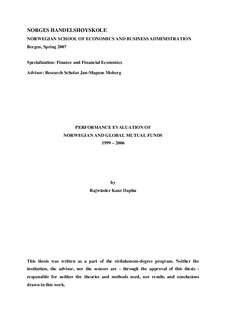Performance evaluation of Norwegian and global mutual funds : 1999 - 2006
Master thesis
Permanent lenke
http://hdl.handle.net/11250/170233Utgivelsesdato
2007Metadata
Vis full innførselSamlinger
- Student Papers [69]
Sammendrag
In this study I evaluate the performance of a sample of eight Norwegian mutual funds and eight
global mutual funds over the period January 1999 to June 2006. Norwegian mutual funds
invest in companies, which are listed on the Oslo Stock Exchange and global mutual funds
invest in companies in USA, Europe, Asia and South America. This study examines the riskadjusted
returns using Sharpe’s ratio, Treynor’s ratio, Jensen’s measure, Appraisal Ratio and
Modigliani and Modigliani measure for these Norwegian and Global mutual funds. The
analysis will focus on the funds performances in the form of risk-adjusted return. In the
empirical examination, I have used arithmetic risk-adjusted monthly return. The purpose is to
compare the performances of global mutual funds and domestic mutual funds and seeks to test
whether the mutual funds achieve a higher risk-adjusted excess return than the market and if
the mutual funds have the same risk profile and investment strategy as they claim. On the basis
of the results I found in the empirical analysis, I conclude that only a few funds managed to
generate a risk-adjusted excess return corresponding to the fund’s investment strategy and
profile and few funds have the same risk profile as they claim.
The performance evaluation methods, which are used to rank the mutual funds in this thesis,
have strong positive correlation. This adds robustness to my results. Different fund
management companies charge different management fee from their customers. The results
based on the empirical analysis indicate that the mutual funds, which have lower subscription
cost and management fee, obtain higher risk adjusted returns than the mutual funds with high
subscription cost and management fee.
